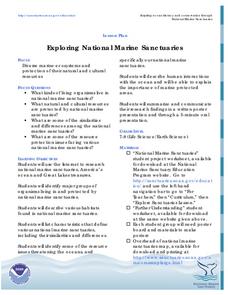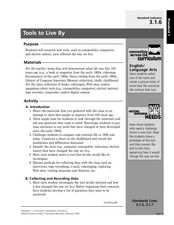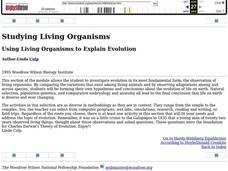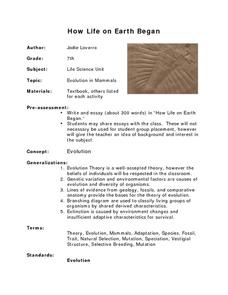Curated OER
Decomposition, Soil, and Life Cycle Research
Students conduct background research on the decomposition process, soil composition, and the life cycle using the resources provided for Internet searches. They work in collaborative groups to research topics as a particular plant, soil...
Curated OER
Life Cycles
Third graders investigate the stages of animal life cycles. They examine an egg and compare it to an inanimate object, read a booklet about the life cycle and define key vocabulary terms, and observe a mealworm. Students then design a...
Curated OER
Searching for life
Students explore the possibility of life on Mars and what that might look like. In this planetary instructional activity students complete several activities on looking for life on Mars.
Curated OER
My Life As An Insect In Namib
Students examine the harsh living environment of the Namib Desert. They watch and discuss a video, record the types of insects observed in the video, record information about insects and animal adaptations in their science journals, and...
Curated OER
What Is Life?
In this life characteristics worksheet, students answer 16 questions about living things, Redi's experiment, basic needs, growth and development.
Curated OER
Exploring National Marine Sanctuaries
Learners research marine ecosystems by creating class presentations. In this oceanography instructional activity, students research the different locations of marine sanctuaries by identifying them on a transparency map in class....
Curated OER
Characteristics of Living Things
Student use the scientific method to experiment with worms. In this characteristics of living things lesson, students predict and examine the reactions of worms to dry and wet soil. Students share their findings.
Curated OER
Tools to Live By
Third graders compare life in the early 1900's with the life today. In this technology lesson, 3rd graders research about the development of a certain technological tool. They collect data and report findings in class.
Curated OER
The Game of Life
Students describe what it means for a marine animal or fish to be threatened or endangered after playing game simulating extinction.
Curated OER
Brine Shrimp Life Cycle
Third graders examine brine shrimp through "A Sea Monkey's Life" story. They study the living environments and life cycle of brine shrimp. They look at brine shrimp and cysts through a microscope, identifying new vocabulary that was...
Curated OER
The Circle of Life
Fourth graders examine how the different organisms living in an ecosystem affect one another. In groups, they research a specific ecosystem and present their findings to the class based on the type of organisms found in it. To end the...
Curated OER
A Day In My Life
Students brainstorm how they can conserve energy in their daily lives. For this energy lesson plan, students discuss how they use energy and ways to conserve it.
Curated OER
The Web of Life
Students construct a food web to learn how living things in an ecosystem are interconnected. In this food web simulation lesson, students will be assigned an animal and the teacher will represent the sun. Students and teacher discuss...
Curated OER
Needs of Living Things
Students discuss and explore the needs of living things. They choose to create a slide show with captions, create a web showing the needs of one Organism using KidPix. or make picture book by hand or using Microsoft Publisher.
Curated OER
Living With Risk: The Human Element of Natural Disasters
Students explore human elements that are a part of natural disasters, read a Hawaiian myth, conduct a survey, discuss why people choose to live in high risk areas, and participate in a writing activity based on studenT real life accounts...
Curated OER
Using Living Organisms to Explain Evolution
Students investigate evolution in its most fundamental form: the observation of living organisms. By comparing variations that exist among living animals, students formulate their own hypotheses and conclusions about the evolution of...
Curated OER
Web of Life - Role-Playing
Students role-play how organisms adapt to their environment. They play 20 questions with plant and animal habitats. They create a web of life to demonstrate how each plant and animal relies on the other for survival.
Curated OER
Marine & Aquatic Habitats Activities - Creatures in the Coral
Students describe unique adaptations of organisms that live in the coral reef habitat, read various books pertaining to coral reefs and ocean life, and construct a wheel demonstrating the relationships between certain coral reef...
Curated OER
Testing for Life
Students test for organic molecules to determine if a solution contains once living molecules. In this characteristics of life lesson plan, students test common liquids for the presence of organic molecules, including starch, protein,...
Curated OER
Quality of life for kids
Young scholars explore the meaning of quality of life. Also, the need to prioritize means that government spending decisions are political, with winners and losers. Discussion platforms are on the six dimensions to a child's well-being:...
Curated OER
How Life on Earth Began
Seventh graders investigate the concept of evolution and how it was a mechanism for the foundation of life on Earth. They conduct research and attempt to make cognitive connections with the evidence to agree with the presupposition of...
Curated OER
How Are Polymers Utilized in Everyday Life?
Students investigate polymers and their uses in everyday life. In this polymers instructional activity, students are assigned one of the 10 areas of polymer science and they do research on their assigned area using the internet. Students...
Curated OER
Living On The Moon
Students evaluate what life would be like living on the moon or another planet in our solar system. For this science lesson, students create a colony that they would use to live in on the moon using Legos.
Curated OER
Living Light
Learners explain bioluminescence. In this life science lesson plan, students discuss bioluminescence and conjure examples of organisms that carry this trait and how it is useful in their environment.























